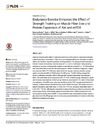Identificador persistente para citar o vincular este elemento:
https://accedacris.ulpgc.es/jspui/handle/10553/52609
| Título: | Endurance exercise enhances the effect of strength training on muscle fiber size and protein expression of akt and mTOR | Autores/as: | Kazior, Zuzanna Willis, Sarah J. Moberg, Marcus Apró, William Calbet, Jose A. L. Holmberg, Hans-Christer Blomstrand, Eva |
Clasificación UNESCO: | 241106 Fisiología del ejercicio | Palabras clave: | Human Skeletal-Muscle Resistance Exercise Messenger-Rna Adenosine Triphosphatase Contractile Activity, et al. |
Fecha de publicación: | 2016 | Publicación seriada: | PLoS ONE | Resumen: | Reports concerning the effect of endurance exercise on the anabolic response to strength training have been contradictory. This study re-investigated this issue, focusing on training effects on indicators of protein synthesis and degradation. Two groups of male subjects performed 7 weeks of resistance exercise alone (R; n = 7) or in combination with preceding endurance exercise, including both continuous and interval cycling (ER; n = 9). Muscle biopsies were taken before and after the training period. Similar increases in leg-press 1 repetition maximum (30%; P<0.05) were observed in both groups, whereas maximal oxygen uptake was elevated (8%; P<0.05) only in the ER group. The ER training enlarged the areas of both type I and type II fibers, whereas the R protocol increased only the type II fibers. The mean fiber area increased by 28% (P<0.05) in the ER group, whereas no significant increase was observed in the R group. Moreover, expression of Akt and mTOR protein was enhanced in the ER group, whereas only the level of mTOR was elevated following R training. Training-induced alterations in the levels of both Akt and mTOR protein were correlated to changes in type I fiber area (r = 0.55-0.61, P<0.05), as well as mean fiber area (r = 0.55-0.61, P<0.05), reflecting the important role played by these proteins in connection with muscle hypertrophy. Both training regimes reduced the level of MAFbx protein (P<0.05) and tended to elevate that of MuRF-1. The present findings indicate that the larger hypertrophy observed in the ER group is due more to pronounced stimulation of anabolic rather than inhibition of catabolic processes. | URI: | https://accedacris.ulpgc.es/handle/10553/52609 | ISSN: | 1932-6203 | DOI: | 10.1371/journal.pone.0149082 | Fuente: | PLoS ONE [EISSN 1932-6203], v. 11 (2), (Febrero 2016) |
| Colección: | Artículos |
Citas SCOPUSTM
60
actualizado el 08-jun-2025
Citas de WEB OF SCIENCETM
Citations
54
actualizado el 08-jun-2025
Visitas
147
actualizado el 07-dic-2024
Descargas
101
actualizado el 07-dic-2024
Google ScholarTM
Verifica
Altmetric
Comparte
Exporta metadatos
Los elementos en ULPGC accedaCRIS están protegidos por derechos de autor con todos los derechos reservados, a menos que se indique lo contrario.
